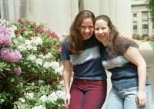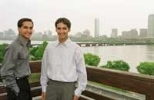There are four sets of twins in the Class of 2001, which one might think is a phenomenon.
Actually, it's a trend.
This is the fifth MIT class since 1990 to have four or more sets of twins in it (the Class of 1999 had five). The Class of 1989 had three sets, a record at that time.
This follows the worldwide trend started in the 1970s when doctors introduced fertility drugs that prompted some women to produce several eggs at a time. Since 1980, the birth rate for twins in developed countries has increased 52 percent, to 29 sets per 1,000 live deliveries, accounted for entirely by fraternal twins. During the same period, the birth rate for identical twins has remained constant at 4 per 1,000 births. Triplet births have increased 404 percent since 1980.
Researchers attribute one-third of the increase to women having babies at a later age and two-thirds to fertility drugs and in vitro fertilization techniques.
The first sets of twins in the Association of Alumni and Alumnae database are Harold and Percy Bugbee and Alfred and Elbridge Watson of the Class of 1920. Single sets of twins appeared in the Classes of 1941, 1946 and 1951.
Twinhood can be a definite asset at MIT.
THE YUDITSKAYA TWINS
Sophia and Susan Yuditskaya didn't plan to attend the same college. It just happened that way, much to their delight.
"We told ourselves that we would each choose the school that we liked best and independently we both chose MIT," said Susan, a chemistry major who will attend medical school at Stanford or the University of Pittsburgh next year.
"I can definitely say that had we ended up at different colleges, I would have been a lot more lonely without my twin sis around," Susan added. "It's great sharing laughs and good times together. When things seem to be going wrong, I come running to cry on her shoulder and she always makes me feel better. Sophia is my best friend."
"I can't imagine a more mutually trusting relationship than the one Susan and I share," said Sophia, an electrical engineering and computer science major who plans to work as a programmer before attending graduate school. "Growing up as twins and being together at MIT has made us count on each other for moral support and honest criticism."
They are different in as many ways as they are similar. Sophia, a programming whiz, avoids chemistry, excels in soccer and dislikes eggplant. Susan, an avid runner, loves eggplant and lives for chemistry. Both play the violin and love music, shopping and Chinese food, and share a soft spot for animals. "We're both scared of spiders," said Susan.
Since they chose different majors, the Yuditskayas rarely saw each other on campus, even though both live in Next House. "We began missing each other so much that we started scheduling our dinner time in advance so we spend some time together," said Sophia.
Sophia (who is 19 minutes older) and Susan were pronounced identical when they were born on October 18, 1978 in Pittsburgh. They aren't so sure. "We don't think we look that much alike," said Sophia. Susan added, "It amuses us when we are mistaken for each other."
THE SOMANI TWINS
"Having a twin definitely pays off at MIT when looking for someone to do a problem set or group project with, especially because we know each other's strengths and weaknesses," said Ashutosh Somani, the older of identical twins by five minutes. His brother Paritosh added, "Ironically, being a twin adds a sense of uniqueness because people are, like, 'Cool!' when they see us for the first time."
"A huge advantage," added Ashutosh, "is that we each get four graduation tickets so our extended family can come to graduation."
The Somani twins, born in New Delhi, India on February 11, 1979, were raised in Ames, IA. Members of Phi Beta Epsilon, each will receive the SB and MEng in electrical engineering and computer science. They both minored in economics.
Paritosh, whose twin says he is "more aggressive," will work as an investment banker. Ashutosh, whose brother says he is "more conservative," will be a consultant. "People say that's pretty fitting of our personalities," Ashutosh said.
They have similar interests in virtually everything, including food, sports, music and academics. "We are really competitive in everything we do," said Paritosh. "Whether it's basketball or video games, we usually get carried away when we are competing against each other. I think our friends realize this and always stick us on the same team."
THE JAGANNATH TWINS
"Yamini is the one person I know I can always count on to help and understand me no matter what happens," said Amitha Jagannath, who is seven minutes older than her sister. "At MIT, where our workload seems endless and our time seems limited, close relationships are essential to mental well-being."
Said her sister Yamini, "It's nice having a friend who will always support you and always be there for you no matter what time it is or how much work there is to be done. That's rare at MIT and in the world."
Their parents were told the records did not indicate whether they were identical when Amitha and Yamini were born on November 11, 1980 in Houston. Amitha is an inch shorter at 5'1" and has a rounder face. Her voice is also higher-pitched. "Sometimes people think we are just sisters and not twins, though this is very rare," said Yamini.
The Jagannaths, who live in East Campus and whose family now lives in New York, majored in biology and plan to take a year off before applying to medical school. Amitha says her sister is "more friendly and outgoing"; Yamani says Amitha is "more patient"; the twins agree that Yamani has the shorter fuse.
The major disadvantage of being twins occurs when tuition comes due. "Sometimes the money will end up in only one of our accounts so the next statement will show that one of us still owes money and supposedly has to pay a late fee," said Amitha.
THE HILL TWINS
Michael and Mark Hill, sometimes referred to as "M and M" at home in Schenectady, NY, will both receive the SB in mechanical engineering. The identical twins are members of Alpha Tau Omega.
A version of this article appeared in MIT Tech Talk on June 6, 2001.







